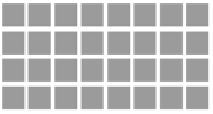Biomedical Engineering Reference
In-Depth Information
D
1
4
D
2
3
2
D
3
1 2345678
Figure 3.19
An example of a droplet-routing plan.
D
1
D
2
D
1
D
2
D
3
D
3
(a)
(b)
D
1
D
2
D
3
(c)
Snapshot
1
2
3
{R3, C1}, {R2, C3},
{R1, C7}
Activation sequence
{R2, C1} {R1, C1}
(d)
Figure 3.20
Schedule A: (a) Snapshot 1; (b) Snapshot 2; (c) Snapshot 3; (d) Activation sequence (in terms of
rows and columns).
plan shown in Figure 3.19, derived from routing methods such as [27], can be
scheduled, that is, implemented, in two ways
(see Figures 3.20
and 3.21)
.
Using the grouping algorithm described in Subsection 3.2.2, the three
snapshots in Figure 3.20 take five manipulation steps in total (three steps for
Snapshot 1, one step for Snapshot 2, and one step for Snapshot 3). However, the
three snapshots in Figure 3.21 only require three manipulation steps (one step
for each). Therefore, the key to obtaining a well-aligned snapshot is the sched-
ule of droplet routes. Compared to the schedule in Figure 3.20, the schedule
in Figure 3.21 carefully orders the droplet movements. Droplets movements
are scheduled in such a way that each snapshot brings the droplets closer to
each other; therefore, their destination cells are more likely to share the same
column/row. By this means, the alignment of the droplets for each snapshot
is improved, which explains the increase in routing efficiency.

















































